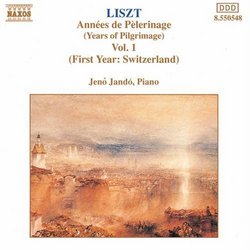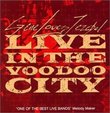| All Artists: Franz Liszt, Jenö Jandó Title: Liszt: Years of Pilgrimage, Vol. 1 Members Wishing: 0 Total Copies: 0 Label: Naxos Release Date: 2/15/1994 Genre: Classical Styles: Forms & Genres, Short Forms, Suites, Instruments, Keyboard Number of Discs: 1 SwapaCD Credits: 1 UPCs: 730099554824, 4891030505483 |
Search - Franz Liszt, Jenö Jandó :: Liszt: Years of Pilgrimage, Vol. 1
 | Franz Liszt, Jenö Jandó Liszt: Years of Pilgrimage, Vol. 1 Genre: Classical
|
Larger Image |
CD DetailsSimilar CDs
|
CD ReviewsJando's Meritorious "Swiss" Hexameron | 08/26/2006 (5 out of 5 stars) "By recording all of Liszt's Years of Pilgrimage, Jeno Jando is a respectable advocate of Liszt's piano music. Many commercial pianists draw upon a few commonplace pieces from the "Pilgrimage" suites to fill their recital discs, but not many are devoted to recording each suite. Jando joins the league of pianists who have done so: Ish-Hurwitz, Arrau, Howard, and some others I cannot recall. Naxos has favored Jando's pianism in their "Complete Piano Music of Liszt" series and although Jando can be an uneven interpreter with some composers, he is at his best with the music of Liszt.
Published in 1855, Liszt's "Swiss" suite is actually a revision of pieces from the Album d'un Voyageur, a collection Liszt began composing as far back as 1835. The present "Swiss" suite is a significant body of work from the 19th-century piano literature. Here Liszt not only operates from the salon virtuoso tradition, but becomes a serious composer who presages Debussy with his evocative musical depictions of nature and pastoral scenes. Jando possesses an acute ability to mold his performance style to this multifaceted suite. Jando commands the magisterial arpeggios of "The Chapel of William Tell" with grandeur and passion. He gives an exceptional delivery of the serene "At the Lake of Wallenstadt" and Schumannesque "Pastorale." The subsequent "Beside a Spring" is an astounding musical example of Liszt's powers of manipulating figurations and texture to suggest trickling water. Jando plays this a little bit faster and louder than other pianists, but this interpretation in no way detracts from the overall impact of the delicate piece. Strangely enough, Liszt did not compose the dramatic and flashy "Storm" piece for the earlier Album d'un Voyageur. Jando's execution of this tempestuous musical painting of a storm is the best I've heard. Jando's performance is electrifying and his articulation remarkably clear. Pedaling is minimal and Jando's tempo is emblazoned with an impetuousness that makes the music more exciting than it intrinsically is. Thanks to Vladimir Horowitz, the "Valley of Obermann" is admired as the profound masterpiece from this suite. Indeed, Liszt taps into the richest font of his creativity with this epic (15-minute) musical picture. Jando surprised me with his impressively dynamic and emotionally involved delivery. In those aching moments akin to Beethoven's Op. 110, Jando is perfectly attuned to the despair. He treats the Sturm und Drang and final triumphant sections with similar gusto and emotional attachment, all aided by a formidable technique. "Eclogue" and "The Bells of Geneva" are worth plenty of commentary, but as far as Jando is concerned, I must point out his success with Liszt's "Homesickness." This piece is prophetic of the darker works Liszt would write in his late period. Comparing the opening bars to "Nuages Gris" is revelatory and "Homesickness" is a visceral statement of loneliness. Jando's rendition is one of the finest I've heard: it is appropriately bleak, slow, and rhythmically unstable. Bottom line: Jeno Jando does a great service to the Liszt discography with all-around superb interpretations of the "Swiss" suite. Most if not all pieces are conveyed with aplomb, passion, and musicality that can stand with the greats (Berman and Arrau)." |

 Track Listings (9) - Disc #1
Track Listings (9) - Disc #1